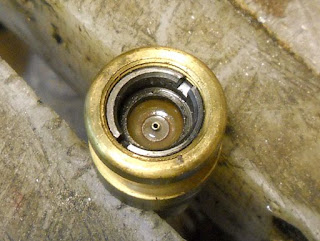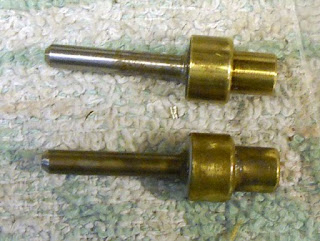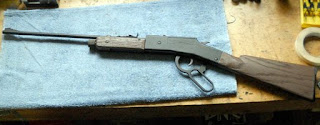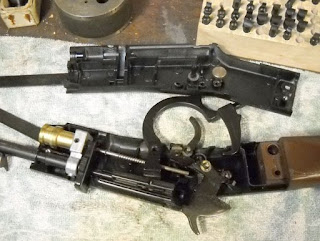Nick was right, of course, to send this to me. No one in their right mind would bother with such a train wreck. Everywhere you look, there's yet another problem.

The wood and plastic furniture needed some serious love. The original brown varnish was just hideous. Since I'd started a black "tactical" (sorry) theme, I decided to see it to completion. Besides, it just seemed easier to paint the wood rather than try to refinish it any other way. Got a can of truck bed liner--tbl for short.

The grips finished in a couple coats. Kinda grippy/gritty. It's OK, better than the varnish I think.

The forend, though had its own plans. It was cut off center from the factory. Veered off to the right at the far end. Barrel channel also wasn't centered. How bad? So bad, I did the initial layout with a medium point Sharpie. I profiled it on the belt sander. Taking off that much material meant losing most of the finger groove on the right side.

I started to recut the finger groove, but when I got to full depth, I ran into a sizable portion of pith. Great. No wood, just pulpy voids. Too bad, really, because the grain was quite nice. Still wanting to salvage the forend, I mixed some 5-minute epoxy with some sanding dust and filled in the finger grooves and the inletting for the front sling attachment band.

Let the epoxy dry for a day, then sanded off the excess.

The barrel channel was still off center.

Using a Dremel tool with a sanding drum, I cut the channel to center.

After test-fitting the action, I deepened the channel to free-float the barrel. It's close, but I could just slide a piece of paper between the wood-to-metal fit.

A .500" aluminum rod wrapped with 150 grit garnet paper helped to hold a straight line when finish sanding the barrel channel. The forend was painted with tbl after this step.

Started to prep for reassembly, but the B3-1 still has it's issues. Since the gun was stripped, it was a simple manner to clean the barrel from the breech. I wanted to give the barrel a quick clean with some JB Non-Embedding Bore Cleaning Compound. Followed by many patches, the usual rust and grime came out as expected. What wasn't expected was feeling the barrel turn slightly in the breech block. Oh, yeah, that's just swell. (Note: Not actually what I said) The barrel could be twisted with moderate hand pressure and would rotate a degree or two.

The barrel is press fit into the breech and pinned. Click the image to enlarge. The upper pin is the one holding the barrel. The lower pin retains the breech block in the compression tube. THAT connection was solid. So far...

Measured the pin diameter at 0.150" Didn't have a brass drift in that size, but I did have a piece of 0.250" brass rod.

Faced both ends on the lathe.

Turned down to about 0.140". Didn't bother to measure it. Just made it fit inside the caliper still set to 0.150".

A few grooves on the handle end of things.

Brass punch-drunk.

Found a maple block with a hole in it...

And drove the pin right out. It wanted to come out right to left.

Barrel went into rubber vise jaws and pulled out.

It's probably not supposed to be quite that easy to remove.

Since it was apart, I chased the M6 x 1 mm threads in the breech block that anchor the action to the forend. The threads were dirty and I could see rust at the bottom of the hole.

A blurry pic of the hole in the breech for the barrel. You can see that it's got a thin coating of rust.

Chopped a cleaning rod off so it would fit in the cordless drill. Mounted a .45 bronze bore brush and cleaned out the rust. Cleaned and degreased the shank of the barrel and the breech.

Mixed up some JB Kwik Weld epoxy. Got about 2 minutes to get the barrel installed before the epoxy starts to set up. The barrel shank diameter, by the way, is 14 mm in diameter and the shank was 61 mm end-to-shoulder. The angle on the cone looked to be 65 degrees.

Couldn't get the barrel seated to the shoulder by hand pressure. A few smacks with a dead-blow mallet took care of business. Used a transfer punch to align the holes for the retaining pin.

Pin went back in left to right. The pin is ground at each end to match the circumference of the tube. I marked the bottom edge of the pin with a carbide scribe as a reference and paid attention when it was reinstalled. Got the curves to match up. Set it aside to dry. By tomorrow, it shouldn't ever unintentionally move again.


t-b-l. Hopefully just one more installment. I'm curious to see how the Weaver base alignment turns out. OK, maybe two more installments. I almost forgot about the nine pound trigger pull.

























